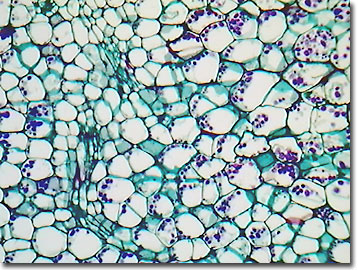Brightfield Digital Image Gallery
Potato Blight Fungus (Phytophthora infestans)
Potato late blight, caused by the fungus Phytophthora infestans, is one of the most important potato diseases in the world. It was responsible for the great Irish Potato Famine of the 1840's, leaving over 1 million people dead from famine-related diseases and resulting in the exodus of more than 1.5 million people from Ireland.

Native to South America and cultivated by Native Americans for thousands of years, the potato plant was introduced to Europe by the Spaniards in the mid-1500s. Although it was probably already carrying milder forms of the late blight fungus, it was not until 1844 that the virulent strain (speculated to be a single clonal genotype of P. infestans) arrived in Ostend, Belgium via a shipment of infected seed potatoes from the United States. Within two years, potato crops in continental Europe, as well as in Ireland, were ravaged.
Disease outbreaks are caused by vegetative reproduction (self-cloning) of the fungus and require cool temperatures and moist conditions. Controlling the fungus is difficult because it has a complicated life cycle with distinct and strikingly different spore forms ranging from motile zoospores (produced by self-cloning) to thick-walled oospores (produced by sexual reproduction). As occurred in 1845 in Ireland, blight can overwinter in unharvested potatoes and release its airborne spores the next season as the new potato stalks grow.
With the emergence of a new strain in the United States during the 1990s, late blight continues to be a looming threat to the world's potato crops. The new strain is virulent and remarkably destructive, devastating apparently healthy potato fields within days. Within hours after the fungus contacts a healthy plant, normal potato plant leaves can be transformed into badly damaged leaves. The recent strain reproduces under lower humidity, making it a threat to potato crops in more arid regions, such as the high mountain valleys of Colorado and Idaho. Prevention through seed piece treatment with fungicides and destruction of cull piles appear to be feasible prevention measures for this economically-devastating fungus, which can overwinter on other hosts such as the bittersweet and hairy nightshade.
Contributing Authors
Cynthia D. Kelly, Thomas J. Fellers and Michael W. Davidson - National High Magnetic Field Laboratory, 1800 East Paul Dirac Dr., The Florida State University, Tallahassee, Florida, 32310.
BACK TO THE BRIGHTFIELD IMAGE GALLERY
BACK TO THE DIGITAL IMAGE GALLERIES
Questions or comments? Send us an email.
© 1995-2022 by Michael W. Davidson and The Florida State University. All Rights Reserved. No images, graphics, software, scripts, or applets may be reproduced or used in any manner without permission from the copyright holders. Use of this website means you agree to all of the Legal Terms and Conditions set forth by the owners.
This website is maintained by our
Graphics & Web Programming Team
in collaboration with Optical Microscopy at the
National High Magnetic Field Laboratory.
Last Modification Friday, Nov 13, 2015 at 02:19 PM
Access Count Since September 17, 2002: 14301
Visit the website of our partner in introductory microscopy education:
|
|
